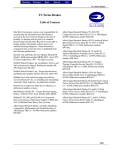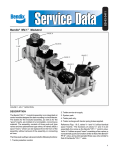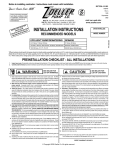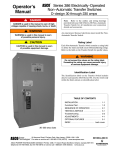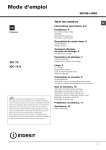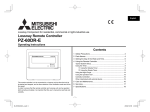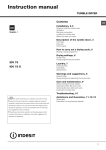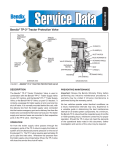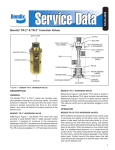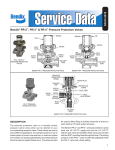Download BENDIX BW1578 User's Manual
Transcript
SD-03-3611 Bendix® PP-1®, PP-2™, PP-5™, PP-8™, & RD-3™ Push-Pull Type Control Valves BENDIX® PP-1® VALVE BENDIX® PP-5™ VALVE BENDIX® PP-2™ VALVE BENDIX® RD-3™ VALVE BENDIX® PP-8™ VALVE FIGURE 1 - PUSH-PULL TYPE CONTROL VALVES DESCRIPTION The PP valves are push-pull manually operable on-off air control valves with an exhaust function. Most are pressure sensitive, so that they will automatically move from the applied to the exhaust position as supply pressure is reduced to a certain minimum, depending on the spring installed. The exception to this is the Bendix® PP-8 ™ valve and some Bendix ® PP-1 ® valves which do not contain a spring. The PP-8™ valve also has a larger diameter shaft for button mounting so that when installed on the same panel with other PP valves the buttons cannot be inadvertently mixed. The PP-8™ valve is normally used to operate tractor spring brakes independently from the trailer. The Bendix® PP-5™ valve is unique in having an auxiliary piston in the lower cover which, upon receiving a pneumatic signal of 18 psi or more, will cause the valve to move from the applied to the exhaust position from a 100 psi application. The PP-2™ valve has an auxiliary port which may be plumbed into a service brake line to release the spring brakes if a service application is made, preventing compounding of forces on the foundation brakes. PREVENTIVE MAINTENANCE Important: Review the Bendix Warranty Policy before performing any intrusive maintenance procedures. A warranty may be voided if intrusive maintenance is performed during the warranty period. No two vehicles operate under identical conditions, as a result, maintenance intervals may vary. Experience is a valuable guide in determining the best maintenance interval for air brake system components. At a minimum, the PP valves should be inspected every 6 months or 1500 operating hours, whichever comes first, for proper operation. Should the PP valves not meet the elements of the operational tests noted in this document, further investigation and service of the valve may be required. The Bendix® RD-3™ valve differs slightly in that it normally remains in the exhaust position and requires a constant manual force to hold it in the applied position. 1 Bendix® Valve Automatic Exhaust Momentary Apply Pilot Trip Feature NonAutomatic PP-1® 20, 30, 40 or 60 psi - - - ™ 40 psi - - - PP-5™ 40 psi - 18 psi - ™ RD-3 - Must be held manually - - PP-8™ - - - Will remain in either position PP-2 PANEL MOUNTING NUT 9 6 Block and/or hold the vehicle by a means other than air brakes and drain all reservoirs. 2. Mark each air supply line and its port for easy reinstallation, then disconnect them. Remove the valve from the panel by removing the panel mounting nut. FIGURE 2 2. Reconnect the air lines using marks made during removal as a guide. 3. Install the operating button. Secure the operating button by installing the button roll pin. DISASSEMBLY: BENDIX PP-1 , PP-8 AND RD-3™ VALVES ® ® ™ 1. Remove the two cap screws (3) which retain the lower cover and remove the cover. Remove the sealing ring (4). 2. Insert a small punch through the roll pin hole in the stem and remove the locknut (5). 3. Remove the inlet-exhaust valve (6) and plunger (7) and spring (8), if any. 4. Remove o-ring (9) from plunger. DISASSEMBLY: BENDIX® PP-5™ VALVE 1. Perform same operations as for PP-1® valve. 2. Remove the inlet seal (10), shown in Figure 4, from lower cover. Remove the ring diaphragm (4) from the inlet seat. 3. Remove piston (11) and o-ring (2). DISASSEMBLY: BENDIX® PP-2™ VALVE 1. Insert a small punch through the roll pin hole in the plunger and remove the locknut (1) from the plunger. 2. Withdraw the plunger and remove the spring (9) and o-ring (8). 2 4 5 1. Drive the button roll-pin out with a punch and remove the button. 1. Install the valve in panel, securing with the panel mounting nut. 7 8 REMOVAL INSTALLATION BUTTON ROLL PIN 3 BENDIX® PP-1® VALVE 3. Remove the two machine screws (2) and remove the lower cover (3). 4. Remove the inlet-exhaust valve (4) and piston (5). 5. Remove o-rings (6 & 7) from piston. OPERATING AND LEAKAGE TESTS BENDIX® PP-1®, PP-8™ AND RD-3™ VALVES 1. An accurate test gauge should be tee’d into the supply line as a means of controlling the supply pressure provided. Apply a 120 psi air source to the supply port. A small volume reservoir (e.g. 90 cu. in.), with a gauge, should be connected to the delivery port. 2. With 120 psi supply pressure, and the button pulled out (exhaust position), leakage at the exhaust port should not exceed a 1” bubble in 5 seconds; at the plunger stem a 1” bubble in 5 seconds. There should be no leakage between the upper and lower body. 3. Push the button in (applied position). Leakage at the exhaust port should not exceed a 1” bubble in 3 seconds; at the plunger a 1” bubble in 3 seconds. (The RD-3™ valve will have to be manually held in this position.) 4. Reduce the supply pressure. At a pressure from 60 to 20 psi, depending on the spring installed, the button should pop out automatically, exhausting the delivery volume. (This does not apply to the RD-3™, PP-8™ or some PP-1® valves). BUTTON ROLL PIN PANEL MOUNTING NUT PANEL MOUNTING NUT 9 8 9 7 4 2 BRAKE VALVE PORT 3 6 6 5 4 7 3 1 FIGURE 3 5 BENDIX® PP-2™ VALVE BENDIX® PP-8™ VALVE FIGURE 5 BUTTON ROLL PIN PANEL MOUNTING NUT 9 9 7 7 8 8 6 10 6 4 4 5 5 3 3 11 2 FIGURE 4 BENDIX® PP-5™ VALVE FIGURE 6 BENDIX® RD-3™ VALVE 3 BENDIX® PP-5™ VALVE 1. Proceed as for Bendix PP-1 valve through Step 3. ® ® 2. Connect a modulated source of air pressure to the pilot air inlet. With the button pushed in (applied position) with 125 psi supply pressure and a gradually increasing pressure applied at the pilot air port the valve should move to the release position with a pilot pressure of not more than 18 psi. Leakage in this mode should not exceed a 1” bubble in 3 seconds at the exhaust port and a 1” bubble in 5 seconds at the plunger stem. BENDIX® PP-2™ VALVE 1. Proceed as for PP-1® valve through Step 1. 3. Push the button in. Supply pressure should be present in the delivery volume. Leakage at the exhaust port or around the plunger stem should not exceed a 1” bubble in 5 seconds. 4. Pull the button out and apply supply pressure at the brake valve port. Supply pressure should be present in the delivery volume and leakage at the exhaust port should not exceed a 1” bubble in 5 seconds. Note: If any of the above push-pull valves do not function as described or if leakage is excessive, it is recommended they be returned to our nearest authorized distributor for a service new or remanufactured replacement. 2. With the button pulled out (exhaust position), leakage at the brake valve port or at the plunger stem should not exceed a 1” bubble in 5 seconds. 4 BW1578 © 2011 Bendix Commercial Vehicle Systems LLC, a member of the Knorr-Bremse.Group • 5/2011 • All rights reserved.




